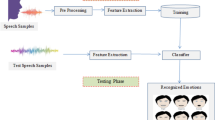
Overview
- Serves as a handy compact document for researchers and students wanting to start exploring the challenges facing automatic emotion recognition in spontaneous speech
- Explains, elaborates, and proposes possible solutions to the existing challenges in spontaneous speech emotion recognition
- Presents case studies based on real-life practical problems
- Lists a set of databases that can be useful to start work in the area of audio emotion analysis
Access this book
Tax calculation will be finalised at checkout
Other ways to access
About this book
Similar content being viewed by others
Keywords
Table of contents (6 chapters)
Authors and Affiliations
About the authors
Meghna Pandharipande received her Bachelor of Engineering (BE) in Electronics and Telecommunication in June 2002 from Amravati University, Amravati. Between September 2002 and December 2003, she was a faculty member of the Department of Electronics and Telecommunication at Shah and Anchor Kutchhi Engineering College, Mumbai. In 2004, she completed her certification in Embedded Systems at CMC, Mumbai and then worked as a Lotus Notes developer in a startup ATS, Mumbai for a year. Since June 2005 she has been with TCS (having first joined the Cognitive Systems Research Laboratory, Tata InfoTech under Prof. P.V.S. Rao) and since 2006, she has been working as a researcher at TCS Research and Innovation - Mumbai. Her research interest is in the area of speech signal processing and has been working extensively on building systems that can process all aspects of spoken speech. More recently, she has been researching non-linguistic aspects of speech processing, like speaking rate and emotion detection from speech.
Sunil Kumar Kopparapu (Senior Member, IEEE; ACM Senior Member India) obtained his doctoral degree in Electrical Engineering from the Indian Institute of Technology Bombay, Mumbai, India in 1997. His thesis “Modular integration for low-level and high-level vision problems in a multi-resolution framework” provided a broad framework to enable reliable and fast vision processing.
Between 1997 and 2000 he was with the Automation Group, Commonwealth Scientific and Industrial Research Organization (CSIRO), Brisbane, Australia working on practical image processing and 3D vision problems, mainly for the benefit of the Australian mining industry.
Prior to joining the Cognitive Systems Research Laboratory (CSRL), Tata InfoTech Limited as a senior research member in 2001, he was an expert for developing virtual self-line of e-commerce products for the R&D Group at Aquila Technologies Private Limited, India.
In his current role as a principal scientist at TCS Research and Innovation - Mumbai, he is actively working in the areas of speech, script, image and natural-language processing with a focus on building usable systems for mass use in Indian conditions. He has co-authored a book titled “Bayesian Approach to Image Interpretation” and more recently a Springer Brief on Non-linguistic Analysis of Call Center Conversations.
Bibliographic Information
Book Title: Analyzing Emotion in Spontaneous Speech
Authors: Rupayan Chakraborty, Meghna Pandharipande, Sunil Kumar Kopparapu
DOI: https://doi.org/10.1007/978-981-10-7674-9
Publisher: Springer Singapore
eBook Packages: Computer Science, Computer Science (R0)
Copyright Information: Springer Nature Singapore Pte Ltd. 2017
Hardcover ISBN: 978-981-10-7673-2Published: 01 February 2018
Softcover ISBN: 978-981-13-5668-1Published: 09 December 2018
eBook ISBN: 978-981-10-7674-9Published: 23 January 2018
Edition Number: 1
Number of Pages: XVI, 81
Number of Illustrations: 31 b/w illustrations
Topics: Artificial Intelligence, User Interfaces and Human Computer Interaction, Simulation and Modeling, Signal, Image and Speech Processing, Pattern Recognition, Computer Appl. in Social and Behavioral Sciences



